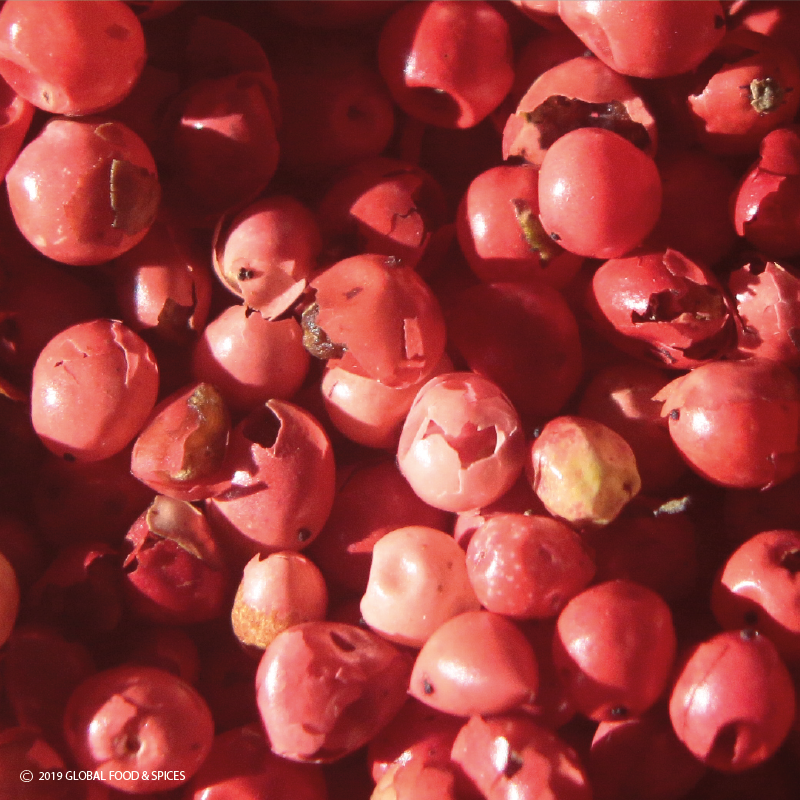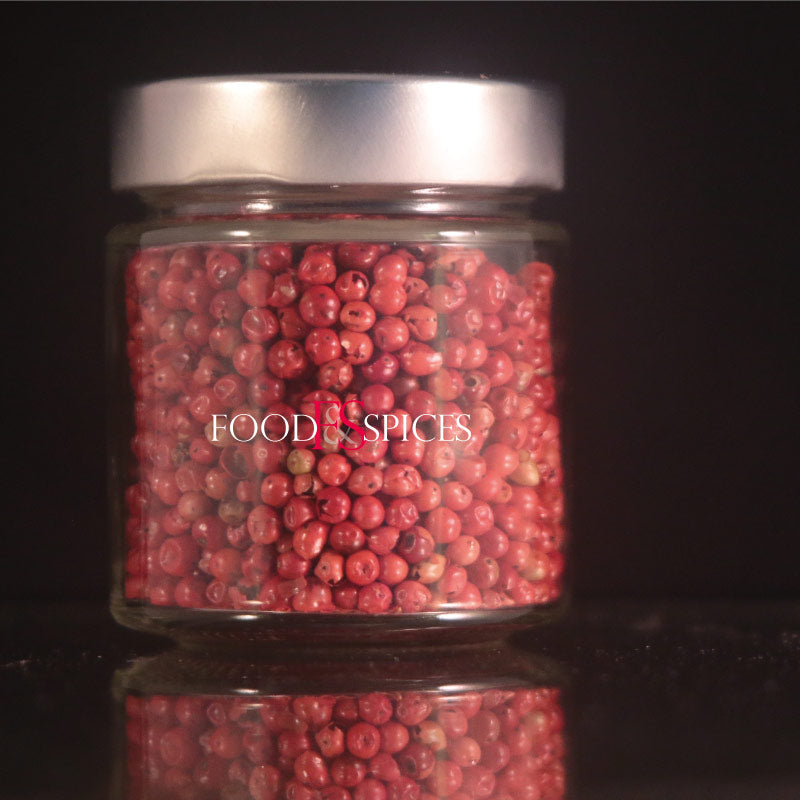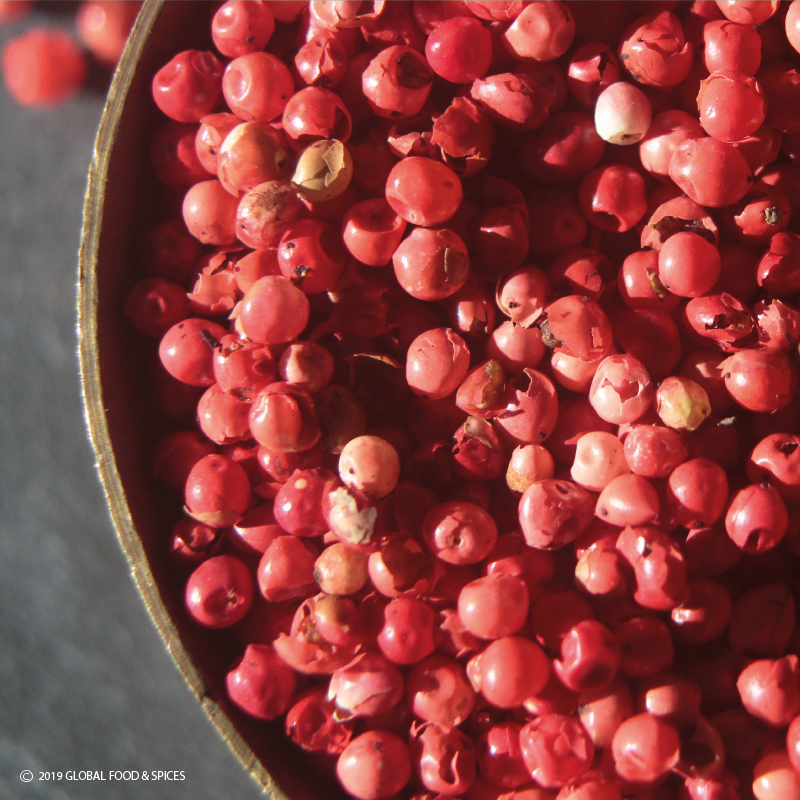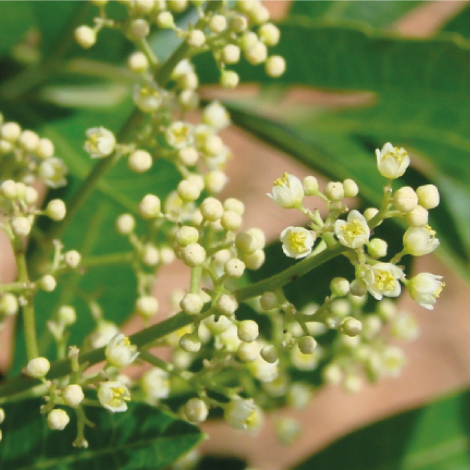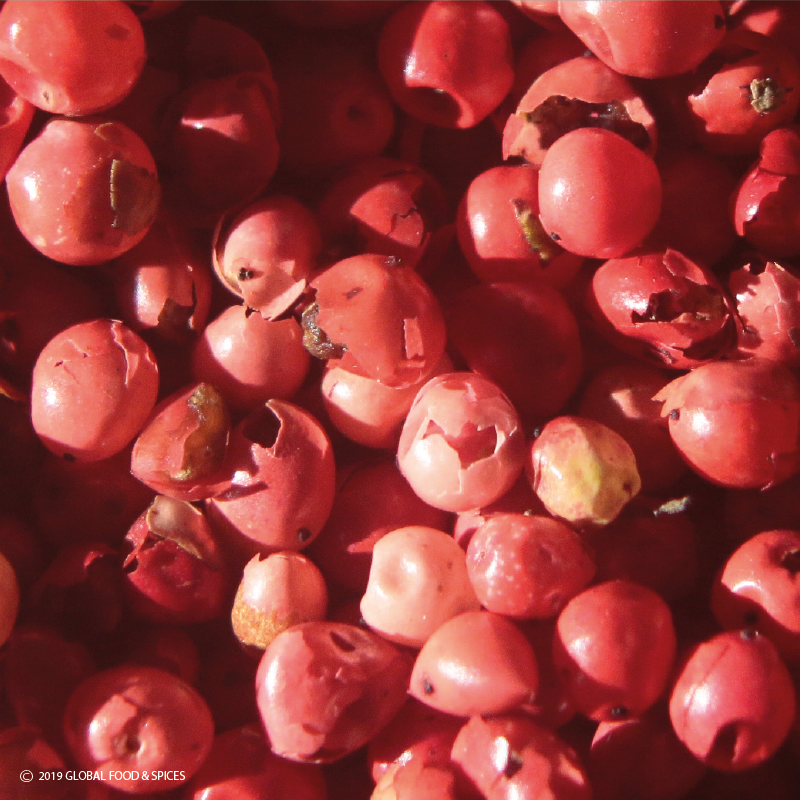The berries of the Brazilian pepper tree are known as "pink pepper." The flavor is subtly sweet rather than sharp, although the berries contain carvacrol, which is also found in herbs like savory, thyme, and oregano. Our pepper is a fragile, freeze-dried berry.
We call this pink fruit "pink pepper," but it's not a pepper, at most a pseudopepper, and the berry is botanically not a berry but a seed pod. The plant/tree is not part of the pepper family (Piperaceae), but of the smoke tree family, a perhaps less familiar family, but one that includes well-known plant species such as the cashew (nut), pistachio (nut), sumac (spice), mango, and Greek mastic.
The Brazilian pepper tree (Schinus terebinthifolia Raddi) is native to South America, as is the Peruvian pepper tree (Schinus molle). Both are used as spices.
Dried pink peppers, however, come primarily from the islands of Madagascar, Réunion, and Mauritius, off the east coast of Africa, including ours. They were "discovered" by French cuisine and planted on the islands in the early nineteenth century. In recent years, pink peppers have also been produced (again) in Brazil.
Pink berries are either air-dried, which gives them a wrinkled appearance similar to black pepper, or freeze-dried. Freeze-drying preserves the berry's smooth shape and better preserves its subtle flavor and color.
Smell and taste
Compared to black pepper, pink pepper is hardly spicy at all. Its sharpness comes from the phenol carvacrol, an antioxidant found in much larger quantities in herbs like savory, thyme, and oregano, in addition to pink pepper. The berries have a distinct juniper flavor (also somewhat sweet), which is why they are also called red juniper berries.
Brazilian pink pepper contains the monoterpenes
- α- and β-pinene, woody pine scent, as in cumin, pine cone, juniper berry and hemp
- β-phellandrene, pleasant mint and citrus flavor, also found in allspice,
- para-cimene, woody and fresh citrus-like as in cumin, thyme, savory and marjoram, and
- cadineen, a fresh woody, vegetal aroma, like in cubeb pepper
Usage
Pink pepper combines perfectly with cloves, cardamom, cinnamon, savory, oregano, tonka beans, vanilla, allspice, pepper, and chili pepper. Pink berries are used whole, as in magret de canard or pâté, but are usually crushed or coarsely ground. Use pink pepper with veal, poultry, delicate fish dishes such as mousses, and with shellfish such as scallops, shrimp, cheese, or in herb butter or pea cream. Delicious when pickled in vinegar.
Also try pink pepper with fruits: peach, orange, melon, mango or papaya. And chocolate, in French tartines (mango) and bread, and even in desserts, such as sprinkling some over peach melba sprinkle or incorporate into peach marmalade.
As a botanical
Just an example: the Phizz Star: 50ml Star of Bombay, 15ml Bottlegreen Plump raspberry cordial, 15ml pink grapefruit juice and 30ml prosecco, finished with pink peppercorn peel crushed between your fingers. Also try Peruvian pink pepper - temporarily unavailable!
Features:
- 100% freeze-dried berries of Schinus terebinthifolia
- origin: Mauritius
Assortment
- available in stand-up pouch, glass and 10 ml test tube
- glass jar contains 30 grams
Gift wrapping
- The jar is available in a tasteful gift packaging, consisting of a cube box filled with black tissue paper.
- For an overview of our gift packaging, please refer to the section gift wrapping
Allergens
Strictly speaking, pink pepper berries are not allergenic. Plants from the same botanical family sometimes experience this. Cross-reactivity, an allergic reaction similar to that of its allergenic relative. Examples include apricot kernels (almonds) and pink peppercorns (cashews). If you are sensitive to cashews - or pistachios - avoid pink peppercorns!
General advice
- pink pepper can be eaten raw and used in hot preparations
- Use the berries whole—also as a garnish—or grind them. Preferably, don't use a pepper mill with a metal grinding mechanism. The peels are so thin and oily that the grinding mechanism quickly clogs. can hit.
- Also consider using only the peels in a dish instead of the whole berries.
Save:
- store your pink pepper in a closed container
- preferably store in a dark, dry and cool place
- best before June 2027 (06-2027)
- This expiration date is an indication
Would you like to know what this pink pepper tastes like?
You can also try a test tube. The tube contains enough pink peppercorn to detect the flavor essence.
Batch number
The batch number helps us track which batch an item originates from. It's listed on the packing slip and invoice.



